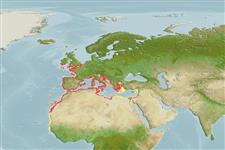>
Blenniiformes (Blennies) >
Tripterygiidae (Triplefin blennies) > Tripterygiinae
Etymology: Tripterygion: Greek, tres tria = three + Greek, pteron = wing, fin; diminutive (Ref. 45335).
Eponymy: Michel Delais worked at the Institute Française d’Afrique Noire at Gorée in Senegal under Dr J Cadenat. He captured virtually all the specimens that the authors studied, including the blenny holotype off Senegal (1950). (Ref. 128868), visit book page.
Issue
Tripterygion xanthosoma is considered valid in Patzner et al. 2009:449 (Ref. 93609).
Environment: milieu / climate zone / depth range / distribution range
Sinh thái học
Biển gần đáy; Mức độ sâu 0 - 40 m (Ref. 4785), usually 6 - 12 m (Ref. 4785). Subtropical; 52°N - 12°N, 19°W - 36°E
Eastern Atlantic and Mediterranean Sea: English Channel southwards and along the coast of west Africa, including Madeira and the Canary Islands (Ref. 4785), south to Senegal.
Bộ gần gũi / Khối lượng (Trọng lượng) / Age
Maturity: Lm ? range ? - ? cm
Max length : 8.9 cm TL con đực/không giới tính; (Ref. 5294); common length : 6.0 cm TL con đực/không giới tính; (Ref. 5294)
Adults inhabit shallow coastal waters with rocky substrate. They are found under overhanging rocks, entrances of caves and other biotopes with reduced light. In the Atlantic, they occur in shallow, light-exposed biotopes. They feed on benthic invertebrates, also on harpacticoids (Ref. 4785), amphipods and other copepods (Ref. 94105). Males court by figure-8-swimming (Ref. 4785). Eggs are hemispherical and covered with numerous sticky threads that anchor them in the algae on the nesting sites (Ref. 240). Larvae are planktonic which occur primarily in shallow, nearshore waters (Ref. 94114).
Life cycle and mating behavior
Chín muồi sinh dục | Sự tái sinh sản | Đẻ trứng | Các trứng | Sự sinh sản | Ấu trùng
Wirtz, P., 1990. Tripterygiidae. p. 916-917. In J.C. Quero, J.C. Hureau, C. Karrer, A. Post and L. Saldanha (eds.) Check-list of the fishes of the eastern tropical Atlantic (CLOFETA). JNICT, Lisbon; SEI, Paris; and UNESCO, Paris. Vol. 2. (Ref. 5294)
IUCN Red List Status (Ref. 130435: Version 2024-2)
Threat to humans
Harmless
Human uses
Các nghề cá: có khả năng có lợi; Bể nuôi cá: Tiềm năng
Các công cụ
Special reports
Download XML
Các nguồn internet
Estimates based on models
Preferred temperature (Ref.
123201): 12.5 - 21, mean 18.7 °C (based on 609 cells).
Phylogenetic diversity index (Ref.
82804): PD
50 = 0.5625 [Uniqueness, from 0.5 = low to 2.0 = high].
Bayesian length-weight: a=0.00617 (0.00288 - 0.01322), b=3.04 (2.86 - 3.22), in cm total length, based on LWR estimates for this (Sub)family-body shape (Ref.
93245).
Mức dinh dưỡng (Ref.
69278): 3.4 ±0.44 se; based on food items.
Thích nghi nhanh (Ref.
120179): Chiêù cao, thời gian nhân đôi của chủng quần tối thiểu là dưới 15 tháng (Preliminary K or Fecundity.).
Fishing Vulnerability (Ref.
59153): Low vulnerability (10 of 100).
Nutrients (Ref.
124155): Calcium = 360 [191, 886] mg/100g; Iron = 2.16 [1.12, 4.22] mg/100g; Protein = 18.4 [17.3, 19.5] %; Omega3 = 0.264 [0.123, 0.562] g/100g; Selenium = 30.7 [11.3, 72.4] μg/100g; VitaminA = 11.1 [2.9, 41.2] μg/100g; Zinc = 1.65 [1.01, 2.57] mg/100g (wet weight);
